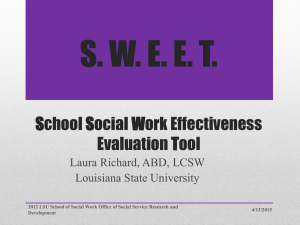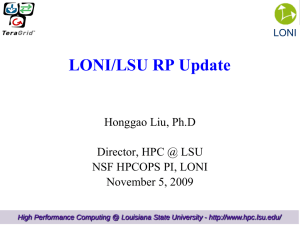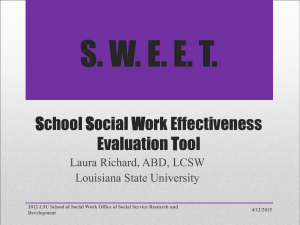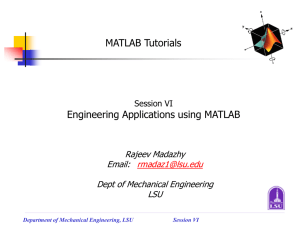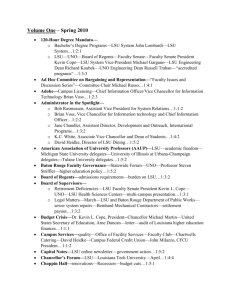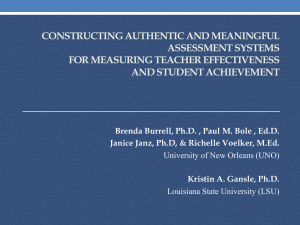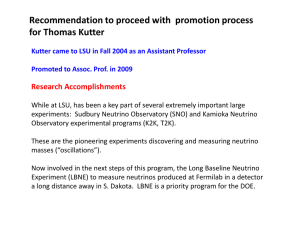Computational Tools for Multiscale Simulations – Bishop
advertisement
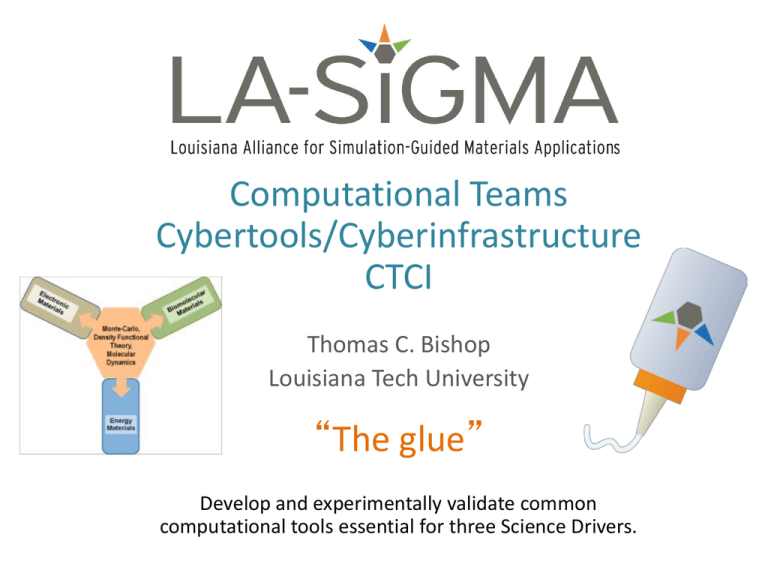
Computational Teams Cybertools/Cyberinfrastructure CTCI Thomas C. Bishop Louisiana Tech University “The glue” Develop and experimentally validate common computational tools essential for three Science Drivers. CTCI Research Themes GPU and Phi Codes Data & Execution Management LA Tech, LSU, UNO LA Tech, LSU, Tulane SD1, SD2, SD3 SD1, SD2, SD3 CTCI Teams Density Functional Force Field Grambling, LA Tech, LSU, Southern, Tulane LA Tech, LSU, Tulane, UNO SD1, SD2 SD2, SD3 Team foci have evolved since the proposal was submitted. CTCI Milestones Milestones Leverage LONI Build on CCT/Cybertools Migrate to Leadership Class Machines Expand LA-SiGMA impact via codes Heterogeneous GPU Computing: A novel collaboration of over 30 faculty, students, and postdocs from LSU, LA Tech, UNO, and Louisiana School for Math, Sciences and the Arts (RET/REU). Using the Collaboratorium* at LSU. Basis for successful MRI and CRI proposals, including a 1PFLOP PHI cluster (equivalent to the world’s fastest machine, Kraken, in 2008) Develop efficient codes to study complex systems on next generation heterogeneous machines like BlueWaters, Stampede, and Titan. Developing codes for quantum and classical systems and drug discovery. *This room was initially renovated as part of an NSF-supported IGERT at CCT. Heterogeneous GPU Computing: Many metastable structures thus many timescales to explore. World’s fastest GPU code at 35 ps/spin flip proposal for 3D Edwards-Anderson glass. TBs of data stored in HDF5 with XML metadata Preliminary result: Finite size scaling shows that there is no transition. Heterogeneous GPU Computing: Computer-aided drug development holds the significant promise of faster and cheaper drug discovery. Swapping between low and high temperature systems (shaded regions) accelerates sampling. A 4-fold speedup is obtained over CPU calculation for single replica, 50-fold for multiple replicas. Scaling of Multi-Scale Methods to 30,000 Cores Interdepartmental collaboration at LSU develops a latency hiding technique. Kraken at the National Institute for Computational Sciences Codes ready for National Leadership Class Machines. Solving the Parquet Equations for the Hubbard Model beyond Weak Coupling, K. Tam, H. Fotso, S.-X. Yang, T.-W. Lee, J. Moreno, J. Ramanujam, and M. Jarrell, Phys. Rev. E 87, 013311 . Selected as NSF Highlight New Algorithm for X-ray Interferometry Data Analysis Traditional Method: FFT (not robust) New and Improved: 1000-fold faster, more robust than Levenberg-Marquardt Butler (LSU) & Johnson(LIGO), Rev. Sci. Instr., Submitted 8 Density Functional Theory • LA-SiGMA member and DFT pioneer John Perdew of Tulane University was elected to the National Academy of Sciences 2011. • 110,000 + Google-Scholar citations for DFT Potentials. Most recently for van der Waals interactions in the semilocal meta-GGA • • New LA-SiGMA member and HPC pioneer William Shelton of LSU has won three Gordon Bell and a Computerworld Smithsonian awards. • Expert in HPC, DFT, and Big Data • Mentoring Mentoring John Perdew Perdew’s election gives LA-SiGMA two of Louisiana’s four members of the National Academies. William Shelton Force field development for ethylene carbonate/ion solutions K+ Cl- Used Thermodynamic Integration (TI) to calculate solvation free energies of ions and determine parameters that agreed with experiment for five ions K+,F-,Cl-,Br-, and I-.. Pair correlations show that the ethylene carbonate binds the ions edge on to ethylene carbonate. Only K+ and Cl- are shown Victoria Bishop, Dexter Taylor, Steve Rick, UNO Chemistry, Summer REU program Reactive Model to Investigate HCl Dissociation at the Surface of Water Contact Ion Pair • Relevant to acid catalysis in biofuel generation, • • hydrolysis and transesterification. Calculated pKa of HCl compares favorably with experiment 5.5 (calc) vs 7.0 (exp) Three step mechanism: 1. 2. 3. • HCl makes oriented contact with water Dissociation into a contact ion pair Further dissociation to solvent separated ion pair Hydronium’s greater propensity for the interface makes the surface of water more positively charged. Molecular HCl Contact Ion Pair Solvent Separated Ion Pair Surface-Induced Nucleation Low surface potential Medium surface potential Surface catalyzes not only the formation of the droplets but also the transition of these droplets into crystal structures due to the surface-induced layering effects (see density profiles plots). When surface attraction is too strong, crystallization may be inhibited due to the spreading of the particles on the surface and the corresponding formation of two-dimensional clusters (see snapshots on the left). Strong surface potential Nucleation of Water Clusters on a Platinum Surface Water clusters on a platinum surface display unconventional hydrogen bonding structures compared to the bulk liquid water. The free energy data (plotted on the right) show unusual oddeven effects that persist for even very large cluster sizes, consistent with the preferred 4-membered ring structures shown Water-Platinum potential is borrowed from Heinzinger, on the left. Spohr, Electrochimica 34 (12), 1849-1856 (1989) Leveraging and Extending LONI Facilities LA-SiGMA REU panel LA-SiGMA collaborative (LONI, BoR) solutions for HD synchronous video, lecture/seminar capture, and sharing. In installation. LA-SiGMA graduate courses Builds upon State LONI investments to bring HD video to each campus. Leveraging and Extending LONI Cybertools to Investigate Genomic Biomaterials Refines and extends tools developed by Cybertools to produce publicly available execution management tools. Millions of simulation and analysis tasks to study folding of DNA managed using collaboratively developed “ManyJobs” and “BigJobs” software. Running Many MD Simulations on Many Supercomputers. LA Tech (Bishop), LSU (Jha), Jack Smith (WVU, XSEDE Fellow) Nucleosomal DNA: Kinked, Not Kinked or Self-Healing Material?, R. Mukherjee and T. Bishop, Frontiers in Nucleic Acids Chapter 5, pp 69–92. ACS Symposium Series, Vol. 1082, 2012 The anatomy of successful ECSS projects: lessons of supporting high-throughput high-performance ensembles on XSEDE. Proceedings of the 1st Conference of the XSEDE '12. Execution Management Across XSEDE Resources BigJobs on LONESTAR 2100 Simulation tasks 240 CPU/simulation 100 Sims/BigJob 2400 CPU/BigJob 500,000 SU in 10 days 2.1ms of simulation 8.2 TB of DCD data 2.1M snapshots analyzed -> 370GB Scalable Online Comparative Genomics of Mononucleosomes: A BigJob. Proceedings of 2nd Conference of XSEDE '13 . Knowledge Discovery and Data Mining (KDD) Classification: Feature Selection / Extraction: finding the features most strongly related to a particular class. Initial Data Selection Target Data Preprocessing classifying or predicting outcomes based on patterns/behavior in data. Clustering: finding new classes or refining existing ones. PreTransformed processed Data Mining Data Transformation Data Data Model Unsupervised Learning: Clustering, Association Rule Discovery Supervised Learning: Predictive Classification models Algorithm Design in Distributed Environment: Scalability, Reliability, Availability, Evolution Interpretation Workflow Management & Data Enabling Technologies Pilot Jobs with SAGA & BigJobs Global Federated File System (GFFS): Data and Queue Management XSEDE Campus Bridging Pilot Project Data Management 2013 Data Workshop June 7-8, 2013 • “Connecting data with semantics and ontologies”. • LA-SiGMA data plan and advisory team • Long term visit • 8 invited experts in data management and semantics • Data sharing through website • Data sharing pilot project with members on all campuses • Pilot projects • • HDF5 + CML/XML Partnership with TACC LA-SiGMA is helping to guide LONI’s efforts. CTCI Milestones Milestones Y1 Y2 Y3 Y4 Y5 Leverage LONI X X X X X On Track Build on CCT/Cybertools X X X X X On Track Migrate to Leadership Class Machines X X X Ahead Expand LA-SiGMA impact via codes X X X On Track Challenges/Barriers: More GPU, data use/reuse, 3 CTCI faculty depart. Mitigation plan: Added a GPU and a data use/reuse expert. Succession plans for departing faculty.

